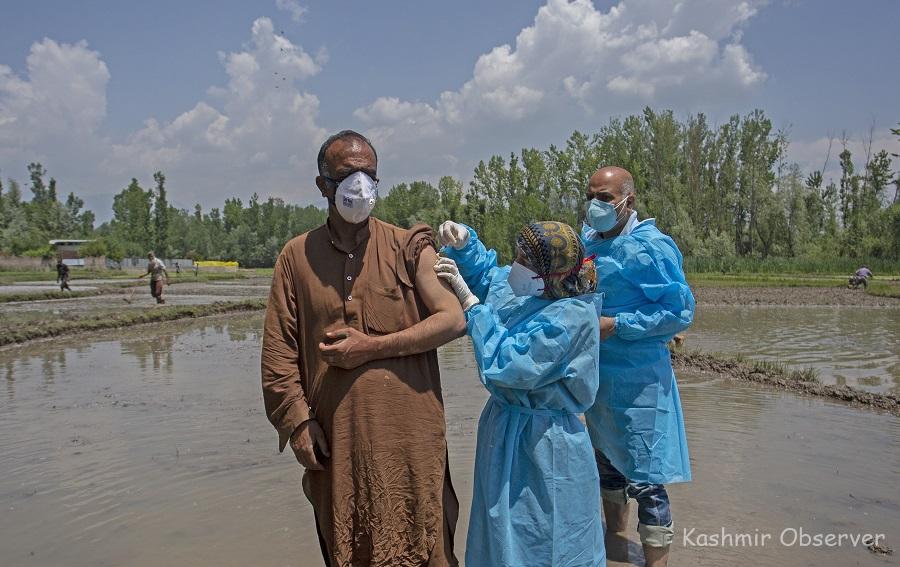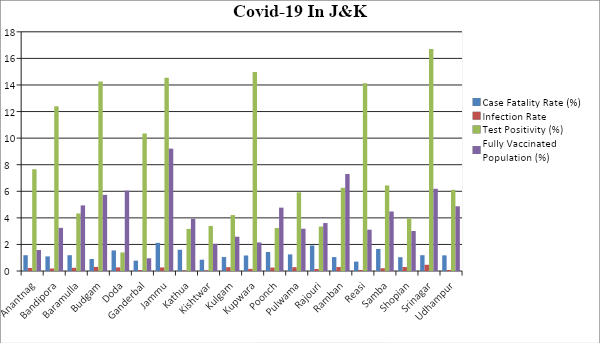 Dose at Door: Healthcare workers carrying out vaccination drives at far flung areas of Kashmir | Photo Credits: Abid Bhat
Dose at Door: Healthcare workers carrying out vaccination drives at far flung areas of Kashmir | Photo Credits: Abid Bhat
Considering the huge disparity in vaccination in two divisions of J&K, accessibility to vaccine allocation data seems the need of the hour
Haris Rashid
JAMMU and Kashmir’s vaccination coverage has a huge disparity among the two divisions of Jammu and Kashmir. Districts in Kashmir have been hit more hard by the Covid pandemic than the districts in the Jammu division. However, in terms of vaccination, the Jammu division has vaccinated more people than the Kashmir division. This should be a cause of concern. It shows that some of the worst-hit districts have still had a discouraging rate of people getting vaccinated.
Consider Jammu district (as of o6 June 2021, 8:16 PM) which has test positivity (%) of 14.55, case fatality rate (%) of 2.12 and infection rate of 0.27. It has administered a total number of 502,981 first doses while fully vaccinating 9.21% of the population. While Srinagar district with test positivity (%) of 16.71, case fatality rate (%) of 1.19 and infection rate of 0.47 has administered 238,565 first doses (which is less than half than that of Jammu) and fully vaccinated its 6.19% population. As of 06 June 2021, Jammu district has inoculated 100% of its above 45 population while Srinagar district has inoculated just 47.72% of its population in the same category. In terms of the percentage of the fully vaccinated population, there are seven districts from the Jammu division that figure among the top ten performing districts among all the districts in the UT. Among the five districts of the UT that have less than 3% fully vaccinated population, four are from Kashmir while only one is from Jammu.
Since vaccination is considered the key to controlling the pandemic, there is a need for transparency in vaccine allocation. District-wise allocation of vaccines should be made available to the public. The allocation should not be made randomly but scientifically based on a formula that takes into consideration among all other factors the people’s vulnerability and severity of the pandemic in a particular district.
While the district-wise information on the number of vaccines administered is available on a real-time basis on CoWin portal and the Jammu and Kashmir government also updates its citizens every day, however, there is no information available in the public domain regarding the allocation. It is often alleged that people in the Kashmir division have vaccine hesitancy and therefore have been left behind in the vaccination process. In this view, the information on vaccine allocation becomes more important. If there is equitable distribution of vaccines among all the districts of the Jammu and Kashmir UT, then it can be concluded that the people in Kashmir are for sure vaccine-hesitant. However, to come to this conclusion, people would need proper information on how the vaccine allocation is being done. It can further help doctors, experts and related organizations and activists to diagnose the problem and act accordingly.
When Jammu and Kashmir was in the midst of a deadly second wave, vaccination came to halt for over a week or more. Infact, on 16th May, zero-vaccination was recorded in Kashmir. Even when vaccination started opening up gradually, slots for the age group 18-45 remained largely unavailable. It was only recently that vaccination has sped up to some extent.
Since there have been several predictions about a third wave and the fact that the pandemic is a matter of life and death, the government must become as much transparent as possible, at least, with regards to the vaccination. Only a transparent government that provides its citizens all the information on how it is controlling the pandemic can overcome the pandemic.

Follow this link to join our WhatsApp group: Join Now
Be Part of Quality Journalism |
Quality journalism takes a lot of time, money and hard work to produce and despite all the hardships we still do it. Our reporters and editors are working overtime in Kashmir and beyond to cover what you care about, break big stories, and expose injustices that can change lives. Today more people are reading Kashmir Observer than ever, but only a handful are paying while advertising revenues are falling fast. |
| ACT NOW |
| MONTHLY | Rs 100 | |
| YEARLY | Rs 1000 | |
| LIFETIME | Rs 10000 | |













